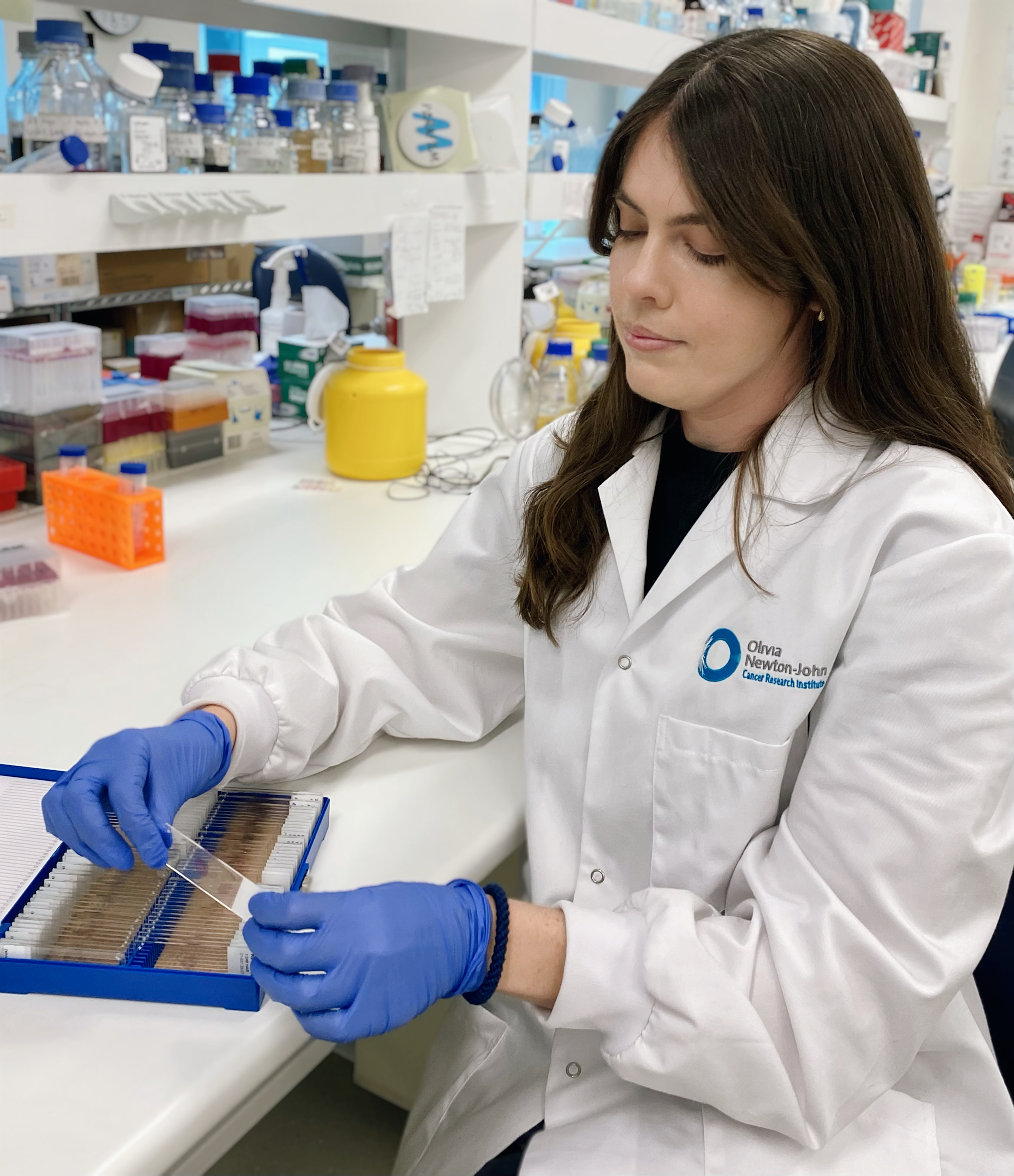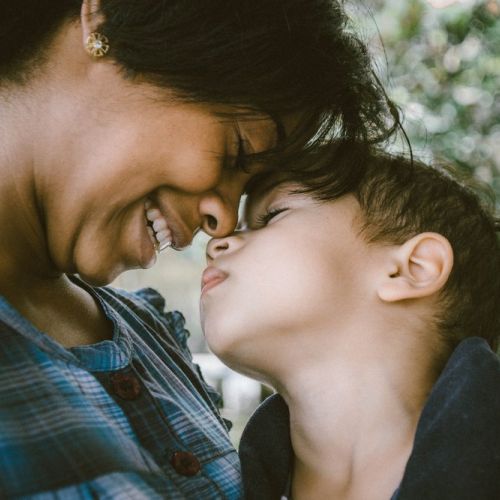3 easy science experiments to do at home
By Alexandra Lapa | 15 August 2023
We’re looking at fun experiments to do with the whole family on National Science Week. Who knows, you may be raising a future scientist!

Cure Cancer volunteer Oli has a go at Dr Nathalie Bock's Making Clouds in a Jar experiment.
With only 8% of Australian youth aged 12-25 intending to pursue a career in science and parents having the greatest influence on their career choices, igniting children's curiosity from an early age is crucial.
On National Science Week (12-20 August), we’re taking a page out of Dr Marlene Hao’s book on raising little scientists. Her own dad was a research scientist who showed her the joys of science early in her childhood. Now that she’s a brilliant researcher herself, she makes sure the love of science continues to pass on to her daughter Isabella by involving her in fun experiments:
1. Floating/sinking blueberries

Materials
- Bowl of water
- Frozen bluebrries (as many as you like!)
- Fresh blueberries (as many as you like!)
Instructions
- Fill a bowl of water.
- Try to predict which blueberries will float and which blueberries will sink.
- Place fresh blueberries in water - what happens?
- Now do this again, this time with frozen blueberries.
“This is a great play activity and also can have surprising results - for example, fresh blueberries sink, but frozen blueberries float," says Dr Marlene.
And no surprise, little Isabella is starting to think like a scientist already. “My daughter is coming up to four, so she’s at the age where everything is accompanied by a tonne of ‘why does this happen?’ questions! We really try to turn this back in her direction and ask her what she thinks, and how she can answer her own question. Of course, this is much harder in practice than in theory, particularly when you’re at the end of a long day!”

Dr Marlene Hao with daughter Isabella.
Dr Nathalie Bock, a Cure Cancer grant recipient in 2020 who worked on bone cancer research, thinks love of science should be encouraged at an early age. “Science is an amazing opportunity for kids to lead their own adventures based on questions they have. You can encourage scientific thinking by including them in a question you are asking yourself and helping them formulate how we could answer the question by actual experiments. Then you can have science kits handy that they can use or run simple experiments at home with materials from local shops.”

Dr Nathalie Bock was funded by Cure Cancer in 2020 for her novel research on bone cancer.
Dr Nathalie suggests this easy-to-do science experiment to help kids understand how clouds are developed:
2. Making clouds in a jar
Materials
- Glass jar with a lid or a mason jar
- 1 cup hot water (be careful it’s not boiling!)
- Food colouring of your choice
- Aerosol hairspray
- 3-5 cubes of Ice
Instructions
- Take a glass jar and pour 1 cup of boiling water into it. You can add food colouring to the water to help differentiate the cloud from the water and give it a sky-like appearance.
- Spray hairspray into the jar quickly.
- Immediately cover the jar with the lid. It's important to do this step swiftly, so make sure the lid is within reach. Having multiple people can be helpful—one to spray the hairspray and another to put on the lid.
- Put 3-5 ice pieces on top of the jar's lid.
- Wait and carefully observe the top of the jar. You'll notice a cloud slowly starting to form.
- Once you've observed the cloud inside the jar, remove the lid and watch the cloud escape from the jar.
For A/Prof Orazio Vittorio, our brilliant childhood cancer researcher, he makes sure that his own kids are immersed in science. “I explain to them what I do for a living - what cancer and DNA are, and why my work is so important. We watch scientific documentaries together and I try my best to explain in lay words some of the complicated terminology. They may not understand everything now, but I want them to be familiar with the terms. I’ve also taken them to the lab several times and they really enjoyed that.”

A/Prof Orazio Vittorio with his family.
A/Prof Orazio thinks that encouraging kids' curiosity about the intricacies of life, in terms of how our bodies function or what occurs in nature, is key to enabling them to view the world with a deeper understanding.
“Whenever my kids are curious about anything, I try to explain to them what may have caused whatever it is that they saw. For example, my 6-year old was amazed to learn where rain comes from. When I told my 10-year old that our DNA is 2m long and is packed in every single cell in our body, it really blew him away.
“What helps them learn is presenting all this information like a game. I never forced my kids to learn something they weren’t interested in. It has to be like a natural discussion or a game that the whole family can participate in.”
Kids can learn more about DNA extraction with this helpful experiment that A/Prof Orazio recommends:
3. How to extract DNA from a strawberry
Materials
- A resealable plastic bag
- 6-10 strawberries without the green leaves
- 2 teaspoon dish detergent
- 1 teaspoon salt
- ½ cup water
- 2 plastic cups
- 1 coffee filter (or strainer)
- ½ cup cold hand sanitiser (or rubbing alcohol)
- 1 coffee stirrer
Instructions
- Put hand santiser in the fridge before beginning the experiment.
- Put strawberries in a plastic bag and seal it. Then, squash the strawberries in the bag until they are well smashed.
- In the first plastic cup, create the DNA extraction solution by adding the following ingredients: 2 teaspoons of dish detergent, 1 teaspoon of salt, and 1/2 cup of water. Mix the solution gently until the salt is dissolved.
- Pour the extraction solution into the bag with the smashed strawberries.
- Reseal the bag and carefully massage and mix the contents for about a minute. Try to avoid creating too many soap bubbles.
- Take the second plastic cup and place a coffee filter over its opening. Open the bag and pour the liquid onto the coffee filter. Allow the liquid to drip through the filter into the cup, leaving the strawberry residue on the filter.
- Almost there! Pour an equal amount of cold hand sanitiser into the liquid in the second cup.
- DO NOT MIX! Observe the formation of whitish, snot-like material in the upper layer of the liquid. This material is the strawberry DNA!
- Use the coffee stirrer to extract the strawberry DNA from the liquid.
Inspiring a love for science in children can ignite a special spark that might grow into a lifelong passion. It could lead them to exciting paths like becoming scientists or using their knowledge to solve global problems - they could very well be among our next generation of thinkers!
If you want to know more about the researchers mentioned in this blog post, you can find out more by reading about Cure Cancer's Projects and Impact.










